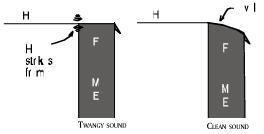Alaska Science Camps, Fairs & Experiments
ANKN is a resource for compiling and exchanging information
related to Alaska Native knowledge systems and ways of knowing. We
are pleased to create and distribute a variety of publications
that assist Native people, government agencies,
educators and the general public in gaining access to the knowledge
base that Alaska Natives have acquired through cumulative experience
over millennia.
TO ORDER THIS PUBLICATION:
Contact the ANKN
offices at 907-474-1902 or email uaf-cxcs@alaska.edu.  Drum
Frames Drum
Frames
While many traditional drums appear simply
made, much care is given to their construction. There is a tremendous
amount of science involved in determining the pitch, timber and
durability of a drum.
Tlingit people make drums about 12"-16" in diameter, covering
them
with deerhide. Fermenting the skin for a while allows the hair to
slip easily.
Drums are culturally very significant, so check with the Elders in
your area to be sure the following suggestions are appropriate.
The skin is washed and fleshed after the hair is removed, then cut
to shape and lashed to the frame in a variety of ways, Experiment
with the different ways. Which way keeps the skin tight and is
easiest to retention? Which way is traditional in your clan or
village?
The outer part of the drum frame should be beveled. If the top of
the frame is flat, the drum will have a strange twang. Make one with
a beveled top and one with a flat top. Can you hear the difference? A
few people make their own frames, but most folks buy them already
formed. They are made of thin strips of wood laminated together
around a round frame.

The striker is made of a stick, often devil's club, and a head,
which is wound string or cloth covered with leather. Make different
strikers: one hard, one soft. What difference do you notice in the
sound?
Does humidity change the pitch of the drum? Why do people often
heat the drum head over a fire before playing it? After painting,
does the drum have a different sound?
Which makes the biggest difference: the size of the drum frame,
shape of the frame, thickness of the skin, tension of the skin, or
type of striker?
Yupik and Iñupiaq drums are made quite differently.
They
are large, two to three feet in diameter. They are held with the face
down and struck with a long slim stick, often hitting the rim. The
rim is thin, made of driftwood, with a wooden handle lashed onto the
bottom of the frame.
Some people have speculated that Yupik and Iñupiaq
drums
are larger because it is much more difficult to bend coastal
driftwood than the live trees of the Interior and Southeast Alaska.
The drums had to be bigger to keep the frames from snapping.
The covering used to be made of walrus gut, but nowadays people
use airplane fabric. The sound is almost the same, and fabric is much
easier to obtain and maintain.
Make different size drums. Use different size strikers. If you
can, compare the sound of a drum made with walrus gut with one made
of airplane fabric. Experiment with different tensions on the
surface: tight and looser. What happens if you make it too tight? How
do you tighten the airplane fabric?
Make different size drums. Do the pitch and sound change? Does
humidity affect the sound?
Contemporary Athabascan drums are similar to Tlingit drums, but
some people say they used to hollow out a cottonwood or spruce tree
and stretch caribou hide over it. Someone should make one of both
kinds and test them for the sound. With science and experimenting,
the reasons for the original materials and shape could be
rediscovered.
Drums make interesting science. There are several variables and
the result is always a product that will last many years.
|